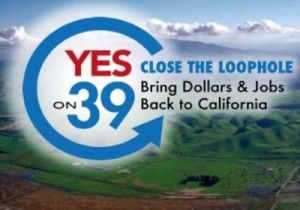Prop. 39 tax-hike $ also may indirectly boost teacher pay
March 7, 2013
By Chris Reed
 It’s not just money from Proposition 30’s sales-tax and income-tax hikes that is being used to provide for teacher pay raises and to allow continuation of “step” pay policies that give teachers raises most years just for time on the job and to maintain “column” pay policies that give teachers raises for meaningless accumulation of graduation school credits.
It’s not just money from Proposition 30’s sales-tax and income-tax hikes that is being used to provide for teacher pay raises and to allow continuation of “step” pay policies that give teachers raises most years just for time on the job and to maintain “column” pay policies that give teachers raises for meaningless accumulation of graduation school credits.
It turns out that the other tax-hiking measure that won approval in 2012 — Proposition 39 — is also a vehicle to that end. The measure blocked multistate corporations from getting to pick where they paid their taxes on revenue generated in California. It is expected to yield about an extra $1 billion a year to the state treasury. It’s long been anticipated that some of the money would be used to increase energy efficiency in school districts.
But instead of distributing the money to schools with the most needs, Gov. Jerry Brown is instead proposing to base its distribution on “Average Daily Attendance,” the same basic method that is used to determine how much money the state gives school districts — and to do so with relatively little oversight. Districts, which stand to get $2.6 billion over the next five years, would basically self-report on their compliance.
This has already triggered complaints from early sponsors of Proposition 39 and criticism from the Legislative Analyst’s Office. Both say that spending should be targeted.
A clandestine way to divert money to teacher compensation
But this is even more of a scam than is understood. The problem isn’t just that the spending isn’t prioritized to get the money to where energy efficiency is the biggest concern. It’s that the language of Brown’s proposal appears to allow districts to spend their Prop. 39 funding on energy-related items in their operating budgets. This would free up more funds for employee compensation, which consume more than 90 percent of the regular budget in many districts.
School districts have been caught lying about attendance, stealing school lunch money, and misusing billions in bond funds — all so as to free up money to keep the automatic raises going to teachers. Diverting Prop. 39 funds would be a relatively minor sin on this front.
All of which brings me back to Reed’s Law, which I wrote about here last month. That law: Whether in the Legislature or in local school districts, the top priority is always freeing up or increasing revenue to allow tenured teachers to receive the automatic “step” raises that typically are provided for 15 of their first 20 years on the job — just for showing up.
Understand this, and California politics becomes demystified and uncomplicated.
Understand this, and it’s no surprise that a ballot measure that’s ostensibly about ending a tax loophole and promoting energy efficiency ends up being one more stealth measure to preserve automatic teacher raises.
The conventional wisdom about the California Teachers Association being a powerful player in Sacramento doesn’t come close to describing the truth. The CTA’s push to protect the pay and tenure of veteran teachers is so powerful, intense and unrelenting that it distorts policies in areas that seem to have little overlap with education.
I look forward to the day that “investigative journalist” Evan Halper points this out.
Related Articles
GOP Finally Gets Budget Action
MARCH 26, 2011 By JOHN SEILER There are a lot of problems with the list of budget demands Republicans proposed,
Governor’s race: Kashkari launches campaign on jobs and education
Republican Neel Kashkari launched his campaign for governor on Tuesday, promising that, if elected, he’ll focus on two issues: jobs and education.
Texas Latinos out-achieve CA Latinos in broad array of categories
Heritage Foundation senior editor Mike Gonzalez has a new book out this month, “A Race for the Future: How Conservatives




